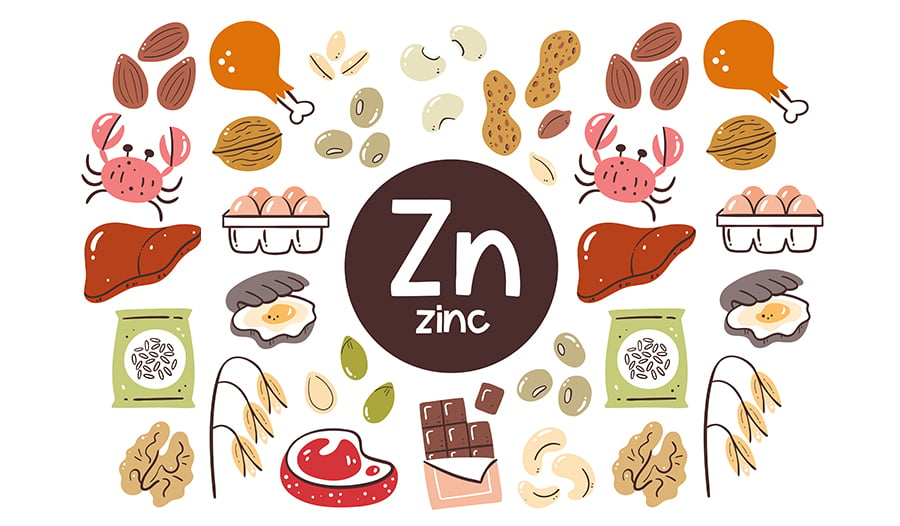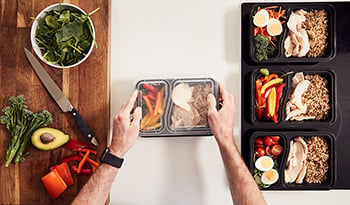The 6 Best Zinc Food Sources: A Guide to Boosting Your Zinc Intake

Zinc is a trace mineral, which means your body only needs it in small amounts. Although your body requires a relatively low intake, zinc plays an essential role. Not getting enough can lead to serious health complications.
How Much Zinc Do You Need?
Adult women require 8 milligrams of zinc daily, while men need 11 milligrams—amounts you can easily achieve through the foods you eat.1 For people who may not meet their zinc needs through foods, many forms of zinc supplements are available to help boost intake. Supplemental zinc may also be especially helpful when your body could benefit from higher intake—like when fighting the common cold.
Like many other micronutrients, zinc is not stored in the body, so it is important to consume it daily. Zinc is crucial for many essential functions in the body, including:
- DNA creation
- Cell growth
- Healthy immune system function
- Wound healing
- Eye health
- Blood clotting
- Thyroid function
- Serves as a cofactor for dozens of reactions allowing enzymes to carry out vital functions
Foods High in Zinc
Meeting your body’s zinc needs is easy when you eat a diet full of whole, zinc-rich foods. Below are some of the foods that pack the most zinc, along with my tips for easily incorporating them into delicious meals and snacks.
1. Seafood
Meat, fish, and seafood are the richest sources of zinc. A 5-ounce can of tuna provides just under one milligram of zinc, and canned salmon offers slightly more.2,3 A homemade tuna salad with avocado mayo makes for an easy lunch that you can customize with seasoning and veggies of your choice. Serve with whole grain crackers for a well-rounded meal incorporating complex carbohydrates and fiber. Also, consider topping your lettuce salad with tuna or salmon for easy protein rich in heart-healthy omega-3 fats.
Tuna and salmon aren’t the only seafood known for their zinc content. In fact, oysters are one of the most concentrated sources of zinc across all food, and sardines provide notable amounts, too.1 These canned options make incorporating zinc-rich foods into quick meals and snacks easy. Combine either of these options into a pasta dish or mix chopped oysters with cream cheese and chives to dip with raw veggies, crackers, or bread. Sardines can be enjoyed straight from the can, served over crackers, or added to salad as a protein source.
Other notable seafood options that provide zinc include shrimp and blue crab.
2. Beef
Beef is another animal food high in zinc. Enjoy a grilled steak with potatoes and veggies, prepare fajita beef for taco night, or brown ground beef to add to your favorite pasta for meals rich in zinc.
Beef jerky is an on-the-go zinc and protein source requiring zero preparation. One ounce of jerky contributes over 2 milligrams of zinc to your daily needs.4 This same one-ounce portion provides nearly 10 grams of protein and only 100 calories, making it a satiating snack. Pair your jerky with dried fruit to incorporate fiber into an easy-to-prep snack.
Zinc is vital for healthy growth and development, so it is essential during periods of rapid growth like pregnancy, infancy, childhood, and adolescence. For this reason, good food sources of zinc are important for new eaters too! Purees containing beef are excellent for incorporating zinc into the diets of young children who can’t yet chew or eat other forms of meat.
For those who choose not to eat beef or seafood, there are plenty of plant-based sources of zinc, too. This means even individuals who follow a vegetarian or vegan diet can find ample sources of zinc in their plant-based diet.
3. Legumes
Legumes include chickpeas, beans, and lentils, which are staples of many plant-based diets. These foods are important sources of protein, a nutrient often under-consumed in vegan diets. Along with protein, legumes also provide zinc. One cup of cooked lentils provides about 2.5 milligrams of zinc and 18 grams of protein.5
Lentils come in several varieties, including red and green, with similar nutrient profiles. If you don’t have time to prepare lentils from scratch, you can buy prepared and seasoned pouches to heat in the microwave or on the stovetop for a quick and flavorful, nutritious meal.
Beans and chickpeas are other legumes that pack impressive amounts of protein and zinc. Preparing dried beans and chickpeas requires a bit more preparation time, but you can add your favorite herbs, spices, and seasonings for the best beans you’ve ever tasted. Canned beans are pre-cooked and ready to add to your meals, salads, or side dishes—or try mashing them for homemade bean burgers.
For other zinc-rich meals that require minimal time in the kitchen, combine multiple sources of high-zinc convenience foods, like a salad with canned beans and tinned tuna. Dry roasted beans are another convenient source of plant-based zinc, or you can customize your own homemade roasted chickpeas with your favorite seasonings.
4. Nuts and Seeds
Another plant source of zinc includes the broad category of nuts and seeds. Although technically considered a legume, we’ll add peanuts to this list, too. In addition to zinc, nuts, and seeds also provide fiber, protein, and healthy fats. Luckily, there are so many varieties of nuts to choose from in many different forms, so they fit a wide variety of dietary and flavor preferences and needs.
For a simple snack, grab a handful of trail mix that incorporates a variety of nuts and seeds, dried fruit, and even some chocolate pieces. Luckily, chocolate is another source of zinc, giving you even more reason to enjoy a sweet treat here and there. Add nuts to your morning oats or dinner salad, or blend them in an afternoon smoothie.
Nut butters also provide zinc and can be enjoyed in countless ways—spread over whole grain bread for a classic sandwich, enjoyed with rice cakes for a gluten-free option, dipped with an apple for a fiber-rich snack, or mixed into Greek yogurt for a protein-packed meal or snack. Dairy is also known for its zinc content, so yogurt and nut butter are excellent sources of this important nutrient.
5. Chocolate
Perhaps the best news you’ve heard all day—chocolate provides essential nutrients! Dark chocolate, in particular, provides about 1 milligram of zinc per ounce. This also comes with about 170 calories, making it a more calorie-dense zinc source. So, keep an eye on your portion size. But if you want a sweet treat after dinner, dark chocolate provides zinc with less sugar than other chocolate varieties, like milk and white. Look for chocolate with over 60% cocoa, which provides more antioxidants, less sugar, and more zinc than options made with less cocoa and more sugar.
6. Whole Grains
Whole grains include familiar items like oats, quinoa, rice, and wheat. While none contain exceptionally high amounts of zinc, they all contribute some of this important nutrient. And when you eat several servings of these foods throughout the day, they can significantly contribute to your overall zinc consumption.
Luckily, many whole-grain foods can be combined with richer sources of zinc to create a meal or snack with impressive amounts of zinc. For example, use whole grain bread when making your nut butter sandwiches, enjoy your morning oatmeal with nuts, nut butter, or seeds mixed in, and add cooked rice and quinoa to your salads that contain beans and legumes. You can also use rice and quinoa as side dishes for cooked meat and seafood that are especially high in zinc.
Although not the richest sources of zinc, whole grains are an excellent source of many other nutrients. They contain fiber, B vitamins, iron, and magnesium, to name a few. Other common foods, like cereal made with whole grains and granola made with oatmeal, nuts, and seeds, are also good sources of zinc. Watch out for added sugar in these foods and choose options with at least 3 grams of fiber.
Takeaway
Zinc is an important micronutrient involved in many of your body’s essential functions. Meeting your zinc needs is easy when you incorporate plenty of whole, zinc-rich foods in your diet. These include animal-based foods like seafood and beef and plant-based foods like legumes, nuts, seeds, dark chocolate, and whole grains. And remember, getting enough zinc in your diet doesn’t have to take a lot of time—enjoy ready-to-eat zinc-rich foods like beef jerky, tinned fish, and pre-cooked beans and lentils for quick and easy boosts of zinc.
References:
- Zinc Fact Sheet for Health Professionals | NIH. Accessed 7/26/23.
- Fish, tuna, light, canned in water, drained solids | USDA FoodData Central. Accessed 7/26/23.
- Fish, salmon, pink, canned, total can contents | USDA FoodData Central. Accessed 7/26/23.
- Snacks, beef jerky, chopped and formed | USDA FoodData Central. Accessed 7/26/23.
- Lentils, mature seeds, cooked, boiled, with salt | USDA FoodData Central. Accessed 7/26/23.
- Chocolate, dark, 70-85% cacao solids | USDA FoodData Central. Accessed 7/26/23.
DISCLAIMER:This Wellness Hub does not intend to provide diagnosis...













































































 Table of Contents
Table of Contents
















